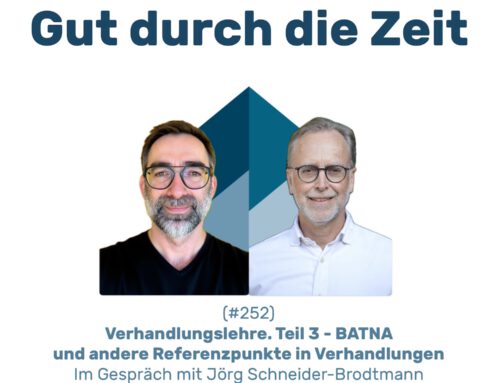#114 GddZ Mediation skills for your own conflict management
Do mediation skills change the way we deal with our own conflicts? In conversation with Günther Mohr
Well through time. The podcast about mediation, conflict coaching and organisational consulting.
Günther MohrDiplom-Volkswirt, Diplom-Psychologe, qualified transactional analyst, senior coach DBVC and BDP, supervisor BDP, mediator, scrum master, Zen teacher, author of numerous specialist books
Contents:
Mediators learn methods, techniques and an overall process in their training and further education programmes in order to mediate and constructively assist (other) conflict parties in their conflict management. This also raises the question of whether and to what extent such competences also influence the occurrence and experience of conflict and how we deal with the potential for conflict in our own lives.
In the inner team of a personality, there is togetherness and opposition and also a mess.
You have to accept that first!
Left:
- www.mohr-coaching.de
- Günther Mohr: Self-mediation, in: Handbuch Transaktionsanalyse in der Mediation, Nomos-Verlag 2014.
Self-mediation with the ego state model -
From a state of mindfulness to a personalised mediation
Excerpts from the technical paper by Günther Mohr
to the handbook: Theory and practice of transactional analysis in mediation,
edited by Dr Sascha Weigel,
Nomos-Verlag, Baden Baden 2014.
Self-mediation is about working with yourself. As attention-grabbing and interesting as conflicts with others are, a conflict always has an internal psychological mirroring level. On closer inspection, solutions also require a change in the person's self-organisation. This can be a change in attitude, behaviour or feelings, which then enables an external change. But how can these inner processes be captured and described?
- Who am I and if so, how many?
Who are we actually and how do we "function"? Who is actually "at home" with ourselves? People have been pondering this question since time immemorial. In his bestseller "Who am I and if so, how many?", Richard David Precht searched for the phenomenon of the ego, and therefore personality, and hinted at its diversity. Udo Lindenberg sings "Actually, I'm quite different, but I only come to it far too rarely". People sometimes experience themselves in the same way, then again differently and react differently depending on the context in which they are placed. At the same time, people have a deep longing to find out who they are and what their core is.
- What you should and shouldn't be - Personality traits
In personality psychology, a distinction is made between concepts that deal with unchangeable personality traits, i.e. that look at the "content" of the person, so to speak, and process concepts that depict the personality in its dynamics and development. The larger branch of personality theory is content theory. They attempt to identify characteristics that characterise people and distinguish them from others. By definition, these characteristics are unchangeable. The so-called "Big Five" with their five characteristics of neuroticism, extraversion, openness to new experiences, agreeableness and conscientiousness have become very famous. There are also numerous variations of the dimensions that C.G. Jung postulated as polarities in his typology: extraversion-introversion, sensory perception-intuition or emotional judgement and analytical thinking.
The market for personality trait theories is booming because they suggest a predictive character. Using their measuring instruments, they promise, for example, to enable laypeople from the business world to make a reliable "judgement" about a person who is about to be hired for a job or promoted to a higher position. Despite the content theories' assertion that all personality traits are "good in the first instance" and that there is no judgement involved, the concepts are used for selection and in feedback rounds that are sometimes bizarre because they are not very appreciative. Giving and receiving feedback in a good way is a major challenge that requires great maturity on both sides in order to succeed. The organisers of assessment centres and development centres are often unaware of this. Companies still like to use these tests as a matter of course because they offer the temptation of an otherwise almost impossible position of power. However, this creates winners and losers. Those wounded by feedback often become coaching clients, because an inconsistency arises between their self-image and the feared external image.
There is now a vast number of personality content theories, but they all have three critical points in common. Firstly, they generally assume that the characteristics are independent of time and context. Personality is defined as enduring. Someone is like this, stays like this, regardless of the environment. This contradicts common sense and experience, especially when people find themselves in more extreme situations. Then you can see their ability to change very clearly, for example in terms of extraversion or introversion. You could then say with Udo Lindenberg: they are actually quite different from how they are behaving now. This more or less apologetic interpretation seems a little weak. If change is possible in principle, it is only a question of the creativity of the coach or mediator, for example, to provide support here.
The second criticism levelled at content theories is their often poor empirical basis. We know from the relevant works of psychology that there are countless personality traits. In the tests, they are always reduced to a manageable level. An attempt is made to identify someone with a few, ultimately unchangeable characteristics. This is due to their construct validity. This means that it is assumed that the construct that the test picks out as a characteristic is really relevant for personality. This is because the characteristics are based on their usability in the business sector, for example. For example, the question of extraversion is naturally interesting for a management or sales role (Blickle, 2013). At this point, the content concept representatives - this is the third point of criticism - also like to stab themselves in the back by offering training to change a characteristic trait, although this actually contradicts the definition of a personality trait. However, offering training is often lucrative for the consultants and creators of the personality theory. And what does the consistency of the theory matter?
However, the personality content concepts can certainly be used in a clarified form. If one thinks systemically and assumes the context-relatedness of certain forms of expression of people and thus their changeability, these personality methods provide a kind of snapshot that must first be examined with regard to its real reliability, i.e. validity with regard to different contexts and situations for the individual case. …
- How do I fit together internally? – Personality process concepts
Personality process concepts say something about how a personality interacts in various elements. These include concepts of personality parts, so-called ego state theories. There is now a whole range of psychological concepts that describe the human psyche as consisting of several personality parts (Federn, 1953; Berne, 1961; Watkins and Watkins, 1997; Allen, 2003; Fritsche and Hartmann, 2010; Peichl, 2013).
Ego states are sub-personalities and are characterised by an inner pattern of experiences and attitudes and are linked to an outer pattern of behaviour (Berne, 1961). In the course of our lives, we form countless ego states when thinking, feeling and behaviour combine to form fixed patterns ("patterns", Mohr, 2012a). We are no longer aware of many of these ego states. But they have an address and a telephone number, as Steiner (1997) once put it. They are not nebulous inner phenomena.
The ego states, which are differentiated as personality traits, are primarily related to each other. And it is the quality of these inner relationships that matters. Because this radiates outwards and is transferred into communication with others. People do not actually form ego states from an early age, but rather relationship states (Little, 2005). It is not their individual impact but the way in which they interact that determines the quality of expression. In his concept of the inner team, Schulz von Thun (1998) described forms of expression analogous to leadership relationships, for example as authoritarian or cooperative.
The relationship can be divided into seven stages (Fritsche and Hartmann, 2010):
- Do the ego states know each other?
- Can they communicate with each other?
- Do the ego states have empathy for each other?
- Can they express understanding for each other?
- Are experiences shared?
- Is there a co-awareness of the different parts?
- Do they work together like an ideal, inner family?
Self-mediation is the work of achieving a state of relationship that enables good communication and co-operative interaction between the ego states. The inner relationship of the ego states is very relevant for external conflicts, as a direct connection can be assumed between behaviour in social situations and the inner relationship representations in the form of the ego states. In the worst case, one's own ego states do not know each other at all or some are completely dissociated. Ideally, the ego states should complement and support each other. And the way in which the ego states interact or the integration of new parts of the personality is clearly possible given the neuoplasticity of the brain.
…





Leave A Comment